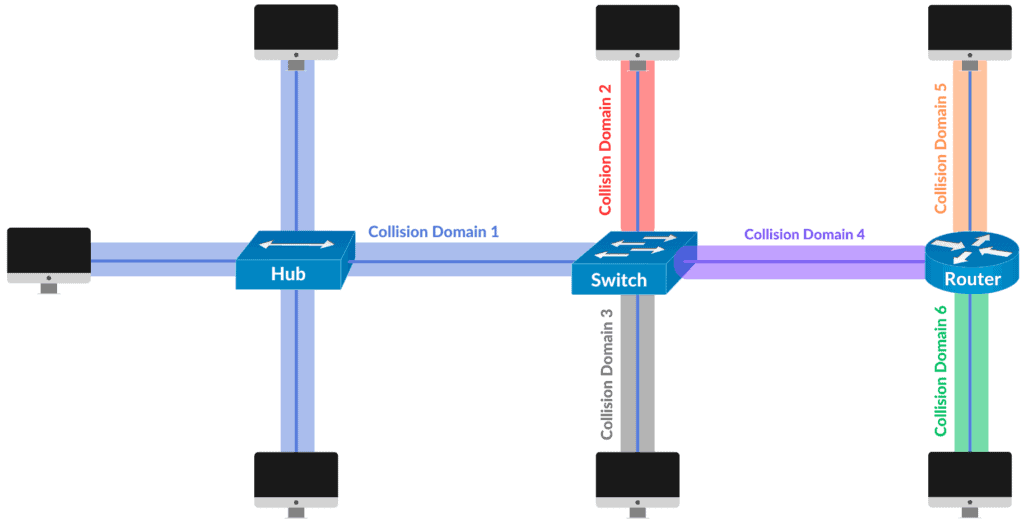1. Introduction
In this tutorial, we’ll study the differences between collision domain and broadcast domain.
First, let’s learn what a collision is and why it occurs. Next, we’ll study what’s collision domain and see an example. After that, we’ll briefly look at the concept of broadcast. Finally, we’ll see what a broadcast domain is and take a look at an example.
2. What’s Collision Domain?
A collision occurs when multiple devices send data simultaneously over a shared communication channel, allowing only one device to transfer data simultaneously. This is because the electrical signals sent by the devices overlap and interfere with each other, making the data unreadable. Therefore, when a collision occurs, data is lost. So, the devices that had sent the data that collided need to resend it.
A collision domain is a network segment where data transmitted by devices belonging to it can collide with each other. If any two devices are part of different collision domains, the data transmitted by both devices will never collide.
A large collision domain is a problem in any network. This is because the larger the collision domain, the greater the chance of collisions occurring. Consequently, by increasing the chance of collisions, the rate of data retransmissions increases, and network performance decreases. Therefore, finding the size of collision domains is an important task. We can measure it by finding out the number of devices whose signals can collide with each other in a network.
Now, let’s look at some examples of how collision domains form in a network.
All devices connected to a hub are in the same collision domain. Thus, messages sent by these devices can collide. The same applies to Wi-Fi networks. So since all devices connected to a Wi-Fi network share the same spectrum, they also share the same collision domain. In Wi-Fi, the CSMA/CA protocol handles this kind of problem.
On the other hand, in a switch or router, each port is part of a different collision domain. Therefore, each device connected to a switch or router is contained in an individual collision domain. Hence, a collision only occurs if the switch/router and a device connected to it send a packet simultaneously and the channel is half-duplex. Otherwise, collisions don’t occur.
The figure below illustrates the collision domains in a network where the devices are connected to a hub, a switch, and a router. We have six collision domains in this example:

Also, in this example, collision domain 1 (in blue) is the largest one, with 4 devices. Note that we include the connection to the switch since signals from the switch can also collide with signals from devices connected to the hub.
So, we see that while hubs keep all devices in one large collision domain, switches and routers give us better separation. This is one reason hubs have fallen out of favor in enterprise networks.
3. What’s Broadcast Domain?
To better understand this concept, let’s first look at the meaning of broadcast. In general, broadcasting is a method for simultaneously transferring a message to all devices connected to a segment of a network.
A broadcast domain is a logical network segment on which a device is able to communicate directly with another device on the same segment without the need for routing. So, when a device sends a broadcast message, that message reaches all the other devices in its broadcast domain.
Large broadcast domains are an issue that we must address properly. Since even fundamental protocols (such as ARP) send broadcast messages frequently, a large broadcast domain can create unnecessary congestion in the network. Hence, we need to be able to determine the size of every broadcast domain in a network. We can measure broadcast domains by finding out the number of devices that can receive broadcast messages from each one in a network.
Let’s now take a look at some examples of broadcast domains.
All ports on a hub or a switch are, by default, in the same broadcast domain. In contrast, all ports on a router belong to different broadcast domains. Also, a device can’t send a broadcast message to devices that aren’t part of its broadcast domain. For this reason, routers don’t forward broadcast messages from one broadcast domain to another one.
The next figure illustrates the broadcast domains in the same network where we exemplified the collision domains earlier. In this case, we have only three broadcast domains:

In this example, broadcast domain 1 (in blue) is the largest, with 6 devices. Note that we include the connection to the router interface since it can also send and receive broadcast messages (for instance, ARP messages).
Finally, although in the figure above, the switch keeps all connected devices in a single broadcast domain, we can change this behavior. This is because modern switches allow us to control the size of the broadcast domains by creating VLANs. Thus, each VLAN corresponds to one broadcast domain.
4. Conclusion
In this article, we studied the differences between collision and broadcast domains.
We’ve seen that the collision domain refers to the set of devices on a network segment where data collisions can occur. By contrast, a broadcast domain encompasses a set of devices that can communicate directly and send broadcast messages to each other.